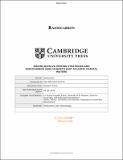Marine bivalve feeding strategies and radiocarbon ages in Northeast Atlantic coastal waters
Abstract
Marine mollusk shells have been extensively used to provide radiocarbon (14C)-based chronologies in paleoenvironmental and archaeological studies, however uncertainties in age measurements are introduced because secondary factors such as vital effects and diet may influence 14C incorporation into these shells. Deep burrowing and deposit feeding mollusks, in particular, may incorporate “old” carbon resulting in apparently older ages than their contemporary environment. In this study, we present paired 14C and stable isotope (δ13C and δ18O) measurements for nine species of known-age bivalves having different feeding strategies and collected in six localities around the NE Atlantic. We exclude potential “old” carbon contamination in these known-age mollusk shells, acquire a better understanding of local ecology and provide an improved context for the environmental interpretation of 14C ages. Our results indicate that, in the NE Atlantic, marine mollusk-derived 14C ages provide a reliable basis for environmental and archaeological investigation, independently of vital effects and differences in microhabitats, feeding strategies and sample location—all of which are apparent from stable isotopes.
Citation
Lo Giudice Cappelli , E & Austin , W E N 2019 , ' Marine bivalve feeding strategies and radiocarbon ages in Northeast Atlantic coastal waters ' , Radiocarbon , vol. First View . https://doi.org/10.1017/RDC.2019.68
Publication
Radiocarbon
Status
Peer reviewed
ISSN
0033-8222Type
Journal article
Description
Authors acknowledge the support of NERC and an award to WA through the RAPID program (project NE/C000137/1).Collections
Items in the St Andrews Research Repository are protected by copyright, with all rights reserved, unless otherwise indicated.

